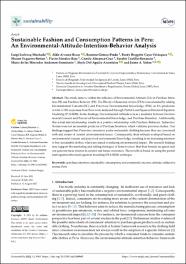Mostrar el registro sencillo del ítem
Sustainable Fashion and Consumption Patterns in Peru: An Environmental-Attitude-Intention-Behavior Analysis
| dc.contributor.author | Leclercq-Machado, Luigi | es_ES |
| dc.contributor.author | Alvarez-Risco, Aldo | es_ES |
| dc.contributor.author | Gómez-Prado, Romina | es_ES |
| dc.contributor.author | Cuya-Velásquez, Berdy Briggitte | es_ES |
| dc.contributor.author | Esquerre-Botton , Sharon | es_ES |
| dc.contributor.author | Morales-Ríos, Flavio | es_ES |
| dc.contributor.author | Almanza-Cruz, Camila | es_ES |
| dc.contributor.author | Castillo-Benancio, Sarahit | es_ES |
| dc.contributor.author | Anderson-Seminario, Maria de las Mercedes | es_ES |
| dc.contributor.author | Del-Aguila-Arcentales, Shyla | es_ES |
| dc.contributor.author | Yáñez, Jaime A. | es_ES |
| dc.date.accessioned | 2022-11-22T22:15:30Z | |
| dc.date.available | 2022-11-22T22:15:30Z | |
| dc.date.issued | 2022-08-12 | |
| dc.identifier.uri | https://hdl.handle.net/20.500.13053/7193 | |
| dc.description.abstract | “This study aims to outline the influence of Environmental Attitude (EA) in Purchase Intention (PI) and Purchase Behavior (PB). The Theory of Reasoned Action (TRA) was extended by adding Environmental Concern (EC) and Perceived Environmental Knowledge (PEK) as EA predictors. A total of 396 responses from Peru were analyzed through Partial Least Squares Structural Equation Modeling (PLS-SEM). In the findings, Environmental Attitude acts as a mediator between Environmental Concern and Perceived Environmental Knowledge, and Purchase Intention. Additionally, this actual interrelationship results in a positive relationship with Purchase Behavior. Subjective Norms were not an essential predictor of Purchase Intention, which validates previous studies. Our findings suggest that Peruvian consumers prefer sustainable clothing because they are concerned with and aware of current environmental issues. Consequently, their attitude is shaped based on environmental concern and perceived environmental knowledge, resulting in an increasing intention to buy sustainable clothes, which are aimed at reducing environmental impact. The research findings may support the marketing and selling strategies of firms to show that their brands are green and can generate more interest in current and future customers. The novelty is based on using the partial least squares structural equation modeling (PLS-SEM) technique“ | es_ES |
| dc.format | application/pdf | es_ES |
| dc.language.iso | eng | es_ES |
| dc.publisher | MDPI | es_ES |
| dc.rights | info:eu-repo/semantics/openAccess | es_ES |
| dc.rights.uri | https://creativecommons.org/licenses/by/4.0/ | es_ES |
| dc.subject | "purchase intention; sustainable consumption; environmental concerns; attitude; subjective norms; Peru" | es_ES |
| dc.title | Sustainable Fashion and Consumption Patterns in Peru: An Environmental-Attitude-Intention-Behavior Analysis | es_ES |
| dc.type | info:eu-repo/semantics/article | es_ES |
| dc.identifier.doi | https://doi.org/10.3390/su14169965 | es_ES |
| dc.type.version | info:eu-repo/semantics/publishedVersion | es_ES |
| dc.publisher.country | CH | es_ES |
| dc.subject.ocde | http://purl.org/pe-repo/ocde/ford#3.03.00 | es_ES |
Ficheros en el ítem
Este ítem aparece en la(s) siguiente(s) colección(es)
-
Web of Science (WOS) [237]


